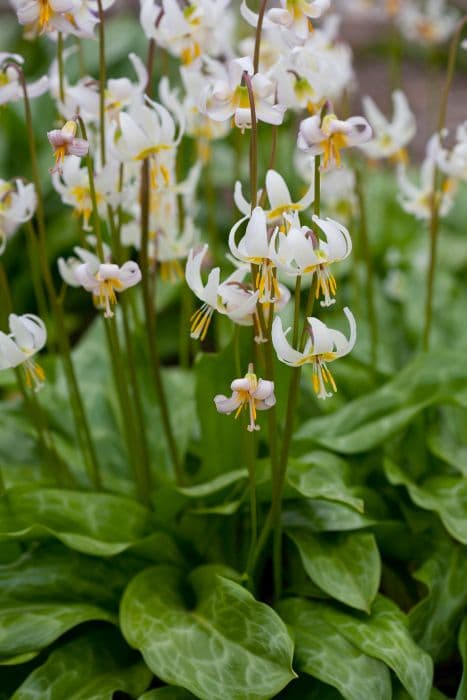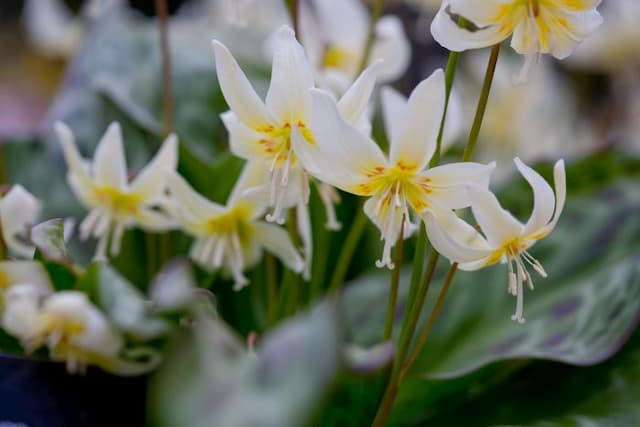Roselily Lilium Roselily Natalia = 'DL04544' (PBR) (Viia-b/-)
![lily [Roselily Natalia]](/_next/image?url=https%3A%2F%2Fplants-admin.emdemapps.com%2Fimages%2Fplants%2F%2Fimages%2F604b60abd9061.png&w=3840&q=75)
ABOUT
The Lilium Roselily Natalia is a striking variety of lily known for its plush, richly layered petals that give it a very full, pompom-like appearance. Its flowers are characterized by a delicate blend of soft pink hues that gracefully transition to a lighter, almost white, edge. The petals are elegantly speckled with deeper pink spots, adding to its sophistication and charm. A unique aspect of this lily is the lack of prominent stamens, which is unusual for lilies and gives it a cleaner look that is also less likely to stain fabrics. The Roselily Natalia has a fresh, light fragrance that is not overpowering, making it a pleasant addition to any setting. The leaves of the plant are a deep, lush green, providing a pleasing contrast to the soft colors of the blooms. This lily typically blooms in the summer, showcasing its beautiful flowers that attract the attention of onlookers and pollinators alike. Its overall appearance exudes elegance and can add a touch of class to gardens or floral arrangements.
About this plant
 Names
NamesFamily
Liliaceae
Synonyms
Roselily Natalia, Double Oriental Lily Natalia, Double Flowered Lily Natalia
Common names
Lilium Roselily Natalia = 'DL04544' (PBR) (Viia-b/-).
 Toxicity
ToxicityTo humans
The plant commonly known as the Roselily, specifically Lilium Roselily Natalia, has components that can be toxic to humans if ingested. The toxic elements are mostly concentrated in the bulbs, but all parts of the plant contain them to some degree. If a person ingests any part of a Roselily, they might experience symptoms such as nausea, vomiting, stomach pain, and diarrhea. In severe cases, it can cause dehydration and electrolyte imbalances. Handling the plant can also cause skin irritation or an allergic reaction in some individuals. It is advisable to seek medical attention if any parts of the plant are ingested or if a skin reaction occurs.
To pets
The plant known as the Roselily, in particular Lilium Roselily Natalia, is highly toxic to cats and can also affect dogs and other pets, though cats are more susceptible. All parts of the plant are poisonous, with the toxicity primarily due to the presence of certain alkaloids. If a cat ingests any part of the plant, symptoms may include vomiting, lethargy, loss of appetite, kidney failure, and it can be potentially fatal. Even small amounts can cause severe poisoning. Dogs may experience milder symptoms, but they can still suffer from gastrointestinal upset and potentially more severe reactions. It is crucial to seek veterinary care immediately if you suspect your pet has ingested any part of this plant.
 Characteristics
CharacteristicsLife cycle
Perennials
Foliage type
Deciduous
Color of leaves
Green
Flower color
Pink
Height
2-3 feet (60-90 cm)
Spread
1 foot (30 cm)
Plant type
Bulb
Hardiness zones
Varies
Native area
Asia
Benefits
 General Benefits
General Benefits- Aesthetic Appeal: The Lilium Roselily Natalia is a visually stunning variety with double flowers that add an elegant touch to any garden or floral arrangement.
- Fragrance: This lily emits a pleasant fragrance, which enhances the sensory experience of any space where the flowers are present.
- Pollinator Friendly: While specifically bred for reduced pollen, it can still attract bees and butterflies, thus supporting local ecosystems.
- Low Maintenance: Lilium Roselily Natalia is relatively easy to care for, requiring only basic gardening practices to thrive.
- Long-Lasting Blooms: The flowers of this lily variety are known for their longevity, both on the plant and as cut flowers in vases.
- Versatility in Landscaping: They can be planted in beds, borders, and containers, offering flexibility in garden design.
- Resistant to Pests and Diseases: The plant has a natural resistance to many common lily pests and diseases, reducing the need for chemical treatments.
 Medical Properties
Medical PropertiesThis plant is not used for medical purposes.
 Air-purifying Qualities
Air-purifying QualitiesThis plant is not specifically known for air purifying qualities.
 Other Uses
Other Uses- Artistic inspiration: The striking appearance of Lilium Roselily Natalia can stimulate creativity among painters and photographers, making it a captivating subject for artworks.
- Floral water: Petals from the plant can be distilled to create a delicate floral water used in perfumery, aromatherapy, or as a linen spray.
- Educational tool: Horticulture students can study the Lilium Roselily Natalia to learn about hybridization, genetics, and plant breeding practices.
- Culinary decoration: While not commonly consumed, the petals could serve as an elegant, non-toxic garnish for sophisticated culinary presentations.
- Wedding bouquets: Due to their abundant petals and lack of pollen, they are ideal for bridal bouquets to avoid any stains on the wedding dress.
- Garden design: The plant can be used to create a focal point in a garden bed or border due to its height and the visual impact of its double flowers.
- Environmental monitoring: By observing the flowering patterns and health of the plant, researchers can gather data on local environmental conditions and climate change impact.
- Botanical illustration: Its complex structure and beauty make the Roselily Natalia a perfect candidate for detailed botanical illustrations used in scientific publications and art prints.
- Dye making: The petals might be used to extract natural dyes for textile or craft projects, although not commonly practiced.
- Phototropism demonstration: As a flowering plant, Lilium Roselily Natalia can be used in classrooms or educational settings to demonstrate phototropism—the way a plant grows in response to light.
Interesting Facts
 Feng Shui
Feng ShuiThe Lilium, commonly known as the lily, can be used in Feng Shui to promote a sense of peace and purity in the home. Its uplifting fragrance and elegant bloom are thought to attract positive chi and can be placed in the living room or bedroom to create a calming atmosphere and enhance the beauty of the space.
 Zodiac Sign Compitability
Zodiac Sign CompitabilityThe Lilium, commonly known as the lily, is not used in astrology practice.
 Plant Symbolism
Plant Symbolism- Purity: Lilies are commonly associated with purity, especially in Christian symbolism where the white lily represents the Virgin Mary's purity and her role of Queen of the Angels.
- Commitment: Often used in weddings, lilies can symbolize the commitment and devotion between partners, representing a union destined to last.
- Renewal and Rebirth: Due to their perennial nature, returning each year with fresh blooms, lilies often signify new beginnings and the rebirth of ideas or projects.
- Motherhood: In certain cultures, the lily is symbolic of motherhood and fertility, celebrating the nurturing aspects of life.
- Passion: While white lilies tend to symbolize purity, other colors of lilies, such as red, can imply passionate desires and love.
- Grief and Condolence: In funerary contexts, lilies can signify the restored innocence of the departed soul and are often a symbol of sympathy during times of loss.
- Transitions: The lily is a bloom that marks significant life transitions and events, reflecting the different stages and cycles of one's existence.
 Water
WaterThe Roselily Natalia should be watered thoroughly whenever the top inch of soil feels dry to the touch. Ensure the plant receives a good soak, allowing water to reach the roots, but avoid waterlogging the soil. An approximate guideline could be to water once a week, but adjust the frequency according to temperature and humidity. You might use about 1 gallon of water for each watering session, depending on the size of the plant and pot. Monitor the plant's response to watering and adjust as needed to ensure healthy growth.
 Light
LightThe Roselily Natalia thrives in bright, indirect light. Place the plant in a location where it can receive plenty of light without being exposed to the harsh midday sun. An east-facing window that gets morning light or a south-facing window with some shade are ideal spots for this plant. Avoid direct sunlight during the hottest part of the day, which could scorch the leaves.
 Temperature
TemperatureThe Roselily Natalia prefers temperatures between 60 and 75 degrees Fahrenheit for optimal growth. The plant can survive minimum temperatures down to about 40 degrees Fahrenheit, but should not be exposed to temperatures below freezing. Ensure that the Roselily Natalia is protected from extreme temperature fluctuations and drafts to maintain its health and bloom quality.
 Pruning
PruningPrune the Roselily Natalia primarily to remove spent flowers and any yellowing or dead leaves to encourage healthy growth and appearance. This should be done after the blooming period, usually in late summer or early fall. Pruning helps redirect the plant's energy to the healthy parts and prepares it for the next blooming season. You may also cut back the stems to within a few inches of the soil after the plant has finished flowering.
 Cleaning
CleaningAs needed
 Soil
SoilThe best soil mix for Roselily Natalia should be well-draining with a mixture of loam, sand, or perlite, and rich organic matter. The soil pH ideal for this plant ranges between 6.0 and 6.5, slightly acidic to neutral.
 Repotting
RepottingRoselily Natalia should be repotted every 2 to 3 years or when the bulbs outgrow their current container, typically after the blooming season.
 Humidity & Misting
Humidity & MistingRoselily Natalia thrives in average room humidity levels, around 40-60%. It does not require particularly high humidity to grow well.
 Suitable locations
Suitable locationsIndoor
Grow in bright indirect light, well-draining soil, and moderate watering.
Outdoor
Plant in well-draining soil, full sun to partial shade, and water regularly.
Hardiness zone
4-9 USDA
 Life cycle
Life cycleThe Lilium Roselily Natalia, commonly referred to as a double-flowered lily, begins its life cycle as a bulb, which undergoes a period of dormancy typically during the colder months. Upon the onset of favorable conditions in spring, the bulb sends up shoots that develop into sturdy stems and leaves. As the plant matures, buds form and eventually bloom into the characteristic large, double flowers that are often fragrant during the summer. After flowering, the plant directs energy back to the bulb as the seeds develop, if pollination has occurred. The foliage yellows and withers away in the fall as the plant re-enters dormancy, which allows the bulb to conserve energy for the next growing season. The cycle repeats yearly, with the bulb enlarging and potentially producing offsets that can be separated to propagate new plants.
 Propogation
PropogationPropogation time
Spring-Early Summer
The most popular method of propagation for the Lilium Roselily Natalia, commonly known as Roselily, is through scaling. This technique involves carefully removing scales from the main bulb during the plant's dormancy period, which is typically in the late fall after the foliage has died back. The scales are then treated with a fungicide to prevent rot and placed in a bag with moist vermiculite or peat moss. This bag is stored in a warm place, around 70 degrees Fahrenheit (approximately 21 degrees Celsius), until bulblets form at the base of the scales, which usually takes a few months. These new bulblets can then be planted in well-draining soil to grow into new Roselily plants. Scaling allows for the multiplication of lily plants while maintaining the genetic characteristics of the parent bulb.









